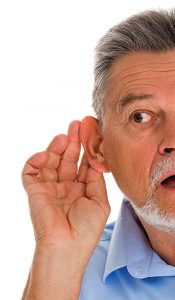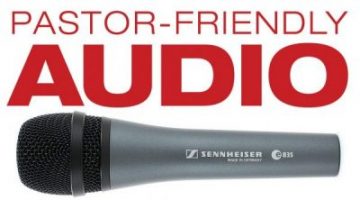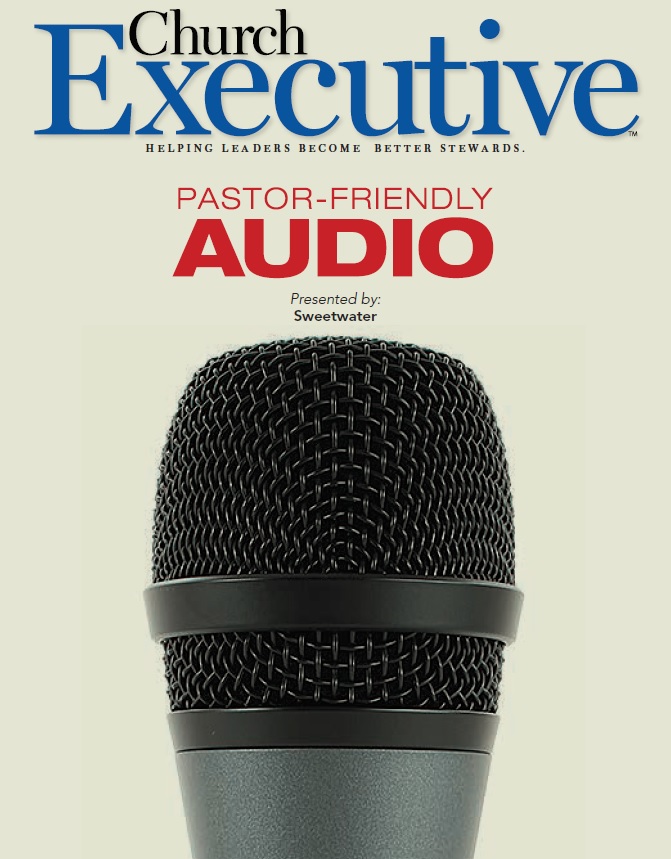
 As a church sound guy, Romans 10:17 is my favorite Bible verse: “Consequently, faith comes by hearing…”
As a church sound guy, Romans 10:17 is my favorite Bible verse: “Consequently, faith comes by hearing…”
After all, true hearing requires that the message is understood.
By Jeff Barnett
 In a previous article, “Choosing the best mic to deliver your message,” we discussed how crucial microphone selection is for ensuring the Word is heard.
In a previous article, “Choosing the best mic to deliver your message,” we discussed how crucial microphone selection is for ensuring the Word is heard.
Here, we shift our attention to the speakers — and by extension, the room itself.
How speech intelligibility is measured
Acousticians use a series of test tones and advanced acoustics measurement equipment, and then rate intelligibility on a scale called the Speech Transmission Index (STI).
A simpler (less scientific) test was outlined in our previous article: position volunteers around the sanctuary; from the pulpit, read aloud from a list of 50 words, and mark how many of the words were correctly understood. Acousticians and sound system designers look for an intelligibility score of 90 percent or higher.
Factors that adversely affect intelligibility
Background noise — How quiet is your sanctuary when no one is speaking? Do you hear HVAC equipment? Traffic noise or sirens? Shuffling feet? Turning pages? Creaking furniture?
For speech to be heard and understood, it must be at least four times (12 decibels) louder than the background noise level.
Also: When your sound system is on, can you hear it running? If there’s an audible buzz or hiss coming from your speakers, you might have an undiagnosed electronic noise problem.
Reverberation time — “Reverb” is how much natural echo a room has, or the “liveliness” of its acoustics. The longer it takes a sound to trail off, the more reverb time the room has.
Reverb is tricky, though: We can all agree that high levels of background noise are bad, but there’s a lot of disagreement about how reverberant a room should be. Despite differing worship music styles, all music sounds better with at least a little natural reverb. More traditional music — especially with choirs and classical instrumentation — sounds beautiful in rooms with lots of reverb, whereas more modern worship music sounds best in “dry” rooms with less reverb.
The trouble is, reverb has a “blurring” effect on speech, masking consonants, emphasizing vowels and making speech harder to understand. The contrasting needs of music and speech should be carefully considered when designing a worship facility’s acoustics.
Adding a sound system to the space can dramatically improve intelligibility; but if it’s implemented poorly, it can actually make matters worse.
Inadequate gain before feedback — Because we know speech needs to be at least four times louder than the background noise level, then we should just make the pastor’s voice that much louder, right? No, because many sound systems simply aren’t capable of producing that much volume without also producing feedback.
A good sound system design, paired with the proper mic, can ensure your system has plenty of power without producing feedback.
Distortion — By “distortion,” I mean any alteration of an original sound. A sound system that’s poorly designed, installed, operated or maintained can adversely alter the sound signal in myriad ways. The goal should simply be speech reinforcement — to make the original speech louder, but otherwise unaltered.
Five problems, five solutions
To reduce background noise: replace old furniture or repair a squeaky door. Other solutions might be more expensive — relocating noisy HVAC equipment and ducts, or adding insulation and additional sheetrock to walls to limit exterior traffic noise. Many “human” noises can be dampened by adding carpeting or padded seats, but even these changes can affect the reverb time of the room. Consult a professional acoustician before making any decisions.

If the room is highly reverberant: improve intelligibility by adding acoustic absorption. But, be careful not to over-dampen the room. If reverb time is too short, music will sound dull, and congregational singing will be stifled. If reverb time is too long, speech is difficult to understand. This is where professional acousticians are worth their weight in gold.
To reduce the volume of the sound system: shorten the distance between the speakers and the congregation’s ears. Instead of using one or two large speakers in the front of the sanctuary, consider installing several smaller speakers throughout the space, mounted on walls, columns, or hung from the ceiling to improve the clarity.
Select the right loudspeakers for your space. If possible, direct the speakers’ output at the congregation, not at walls and ceilings. This avoids exciting the room’s natural reverb and also helps prevent feedback.
To dramatically reduce distortion and electronic noise: repair or replace faulty sound system components. Just like the proverbial “boiling frog,” we often don’t realize that noise has crept into our sound system, or that components don’t sound like they once did. Proper maintenance and routine sound system check-ups ensure quality long-term performance.
With thoughtful design, careful operation and routine maintenance, your congregation can hear and understand the message.
After all, faith comes by hearing.
Jeff Barnett is the Director of House of Worship Sales at Sweetwater. Barnett is also an instructor in Sweetwater’s Academy of Music and Technology, teaching live sound techniques. His background includes live sound engineering, recording engineering, system design, and installation. He is also a performing musician, singing in a vocal jazz group. Over the course of his career, Barnett has helped equip thousands of churches and musicians for their ministry.


